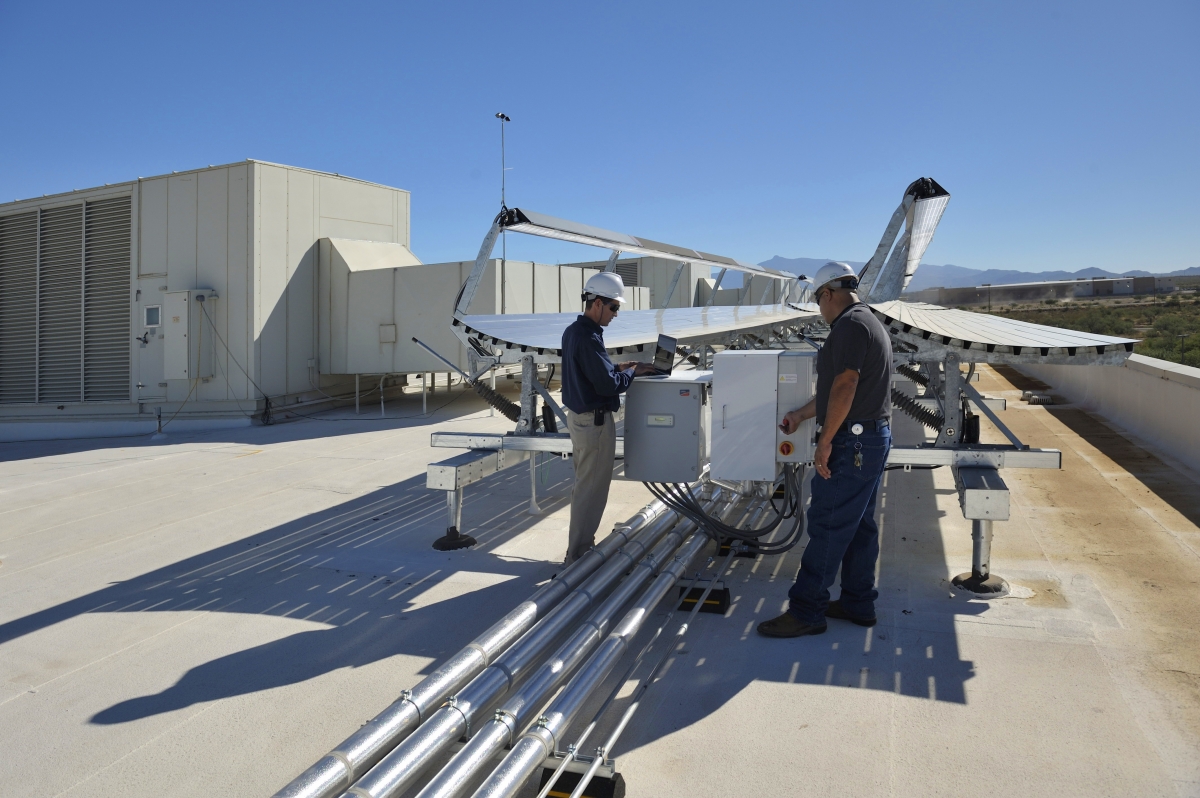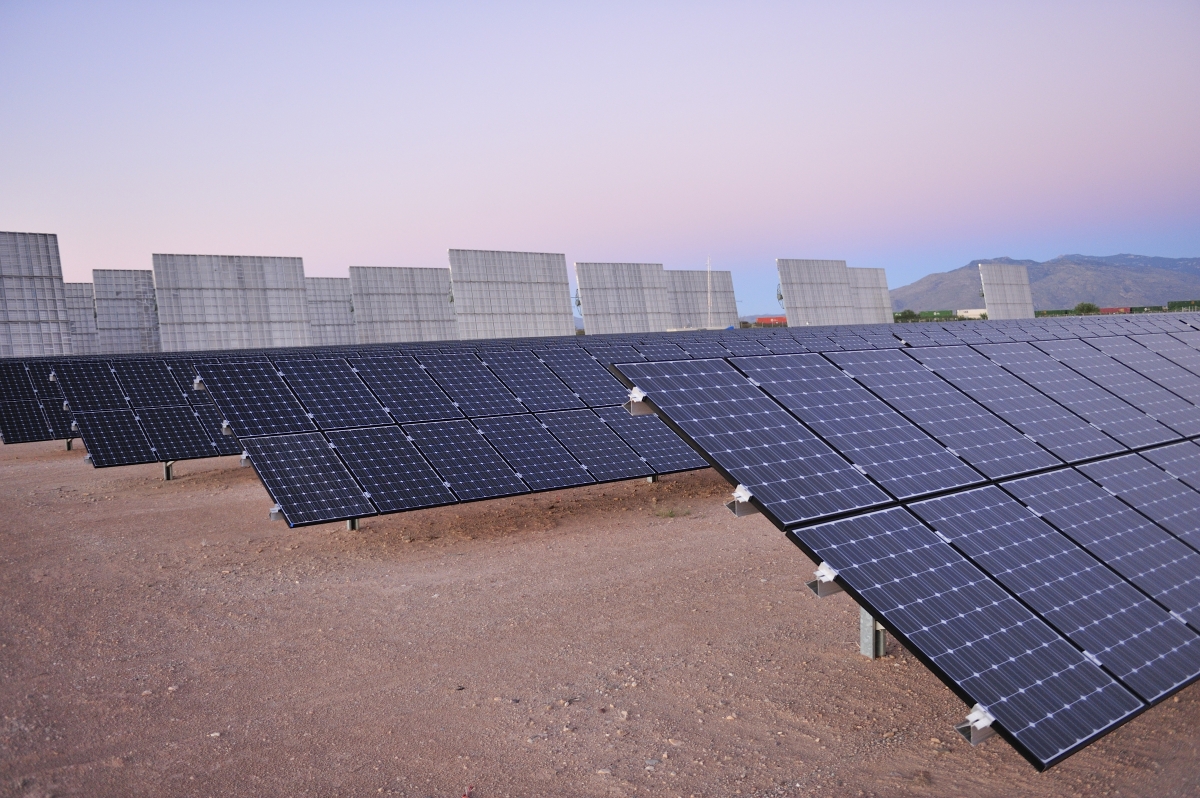Zoning in Solar Energy Innovations
By Claire Rogers
Tucson’s climate can take considerable credit for some of the stronger segments of our economy. Clear night skies foster a thriving astronomy and optics sector, and clear days nurture competitive solar energy advances.
Tucson is home to the Solar Zone, located at the University of Arizona Tech Park, where advanced energy is just one of seven industry sectors of research and development (R&D) particularly well suited to Southern Arizona.
As the largest solar technology test site in the United States, the Solar Zone provides a technology hub for solar innovation companies to demonstrate and evaluate large-scale installations. The 223-acre Solar Zone at I-10 and South Rita Road hosts 10 companies and is capable of generating 25 megawatts of power to feed directly into the power grid, enough to power about 5,000 homes for a year. Tucson Electric Power buys the power generated, helping offset research costs for companies large and small. “Ultimately, solar power has to stand on its own,” says Bruce Wright, Associate Vice President of Tech Parks Arizona. He points out that the nations with the most successful free-standing solar energy projects are getting ahead because of government leadership. When the Chinese government subsidized the construction of solar panels, the cost to consumers of solar panels was driven down considerable, helping prime a new economic pump. Germany and Spain also invested heavily at the front end, leading to widespread adoption of solar as a sensible source of renewable energy. According to Wright, Germany uses more solar power than is used in the entire U.S.
“Ultimately, solar power has to stand on its own,” says Bruce Wright, Associate Vice President of Tech Parks Arizona. He points out that the nations with the most successful free-standing solar energy projects are getting ahead because of government leadership. When the Chinese government subsidized the construction of solar panels, the cost to consumers of solar panels was driven down considerable, helping prime a new economic pump. Germany and Spain also invested heavily at the front end, leading to widespread adoption of solar as a sensible source of renewable energy. According to Wright, Germany uses more solar power than is used in the entire U.S.
Phase One of the Solar Zone allows companies to evaluate how well their test equipment performs when connected to the power grid. Project installations are described in terms of how many homes they power. One of the most visible installations is that of Arzon Solar, which produces 2 mega-watts and powers 250 homes. Within sight of the Julian Wash Greenway, 36 large pedestals each hold up a composite Arzon Solar “system,” the size of an IMAX screen. Each system utilizes dual-axis tracking concentrator photovoltaic technology that maximizes sun-tracking.
The Solar Zones Phase Two focuses more R&D on energy storage, grid optimization, and microgrids, explains Wright, who points out that the nation’s current electrical grid is built for peak demand, which doesn’t take advantage of the latest technical advances in energy management and storage. According to Wright, some of the most significant advances are expected with Phase Two.
“Our current power grid system needs a steady supply of power to continue operating,” says Wright. “Fluctuation in supply are not suitable for highly sensitive equipment. As part of Phase Two in the Solar Zone, the TEP E.ON Climate and Renewables Iron Horse Battery Storage Solar PV facility will provide a 10 megawatt lithium titanate oxide [battery’ storage facility to TEP to level out the dips and peaks in supply.”
REhnu, another Phase Two installation, uses solar optic modules that reflect and concentrates sunlight onto photovoltaic cells. The excess thermal energy is diverted and used to heat water. The modules don’t require as much acreage as conventional flat panels and can be used in remote locations and in places where thermal energy is in demand.
Some of the applications where solar will really shine, according to Wright, will be in Third World countries in Africa and Asia, where power grid are either currently nonexistent or poorly built. Ideally, local microgrids will serve neighborhoods and communities to maximize cost efficiency. The growing sectors of border security and defense will also benefit from solar innovation.
The potential of solar energy has made its way to the U.S.-Mexico border, where advocates are proposing a 2,000-mile string of solar panels along the border that could generate 2,000 gigawatts of electricity each year. The solar photovoltaic arrays could also collect rainwater and provide shad for heat-sensitive crops.
One concern for the future of our power delivery systems, says Wright, is the sustained high temperatures that are a consequence of climate change. Thirteen of the last 15 years now hold high-temperature records. “Our current utility system is built for peak demand,” explains Wright, “and not every system can accommodate those much higher peaks, particularly when efficiency of power delivery is reduced because of the heat.” The Arizona Corporation Commission’s Renewable Energy Standard and Tariff, established in 2006, requires regulated energy utilities to generate 15 percent of their energy from renewable resources by 2025. According to TEP, energy from renewable resources accounted for almost 11 percent of its retail sales in 2016. Most of that renewable energy was solar.
The Arizona Corporation Commission’s Renewable Energy Standard and Tariff, established in 2006, requires regulated energy utilities to generate 15 percent of their energy from renewable resources by 2025. According to TEP, energy from renewable resources accounted for almost 11 percent of its retail sales in 2016. Most of that renewable energy was solar.
Locally, Joe Shoemaker, of Custom Solar and Leisure, is seeing market influences from both advances in solar technology and high adoption rates among utility customers.
“The industry has become so popular that utility business models have become threatened, and they have all tried to aggressively change the way solar production is compensated and want to introduce demand charge to make residential solar less economically viable,” says Shoemaker, noting that solar panel prices are down 400 percent since 2008.
“As more people go solar as a direct result of technological advances and innovation, the utilities will respond with rate changes, and the next wave of solar, with battery storage, will attempt to thwart those rate changes,” says Shoemaker, noting that the solar-plus-storage movement is already underway in California and is a growing trend as battery technology becomes more cost effective.
The centralized grid model made sense 100 years ago, when it was built. Now, however, as homes and business start generating solar power, distribution will become more efficient and resilient, says Kevin Koch, president and co-owner of Technicians for Sustainability.
“The next steps will be o increase the value of on-site solar energy by pairing it with battery storage, and installing building energy controls to shift power use to coincide with solar production,” Koch adds.
For consumers considering solar in Tucson, Koch notes that though new electricity rates will be grandfathered in for 20 years at the existing rates.
For more information on solar power options for home and businesses owners, visit ArizonaGoesSolar.org, a clearing house for solar resources in Arizona.
To read the full article, please click here















